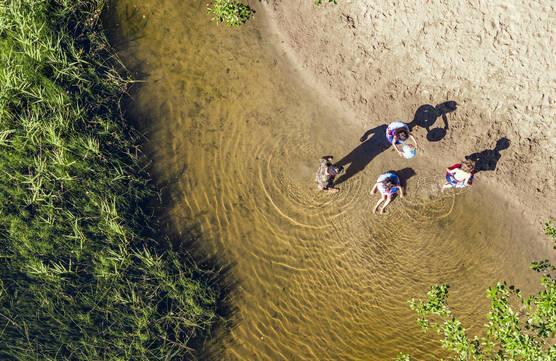Press release 2019-08-27 at 15:48

© Teemu Kuusimurto
Ministry of the Environment and Finnish Environment Institute:
A new assessment of the ecological status1) of surface waters in Finland shows that 87% of the surface area of our lakes and 68% of our rivers are in good or very good condition. Eutrophication is still the most significant problem. There have been no major changes in the status of inland waters since 2013, except for some improvement in certain sites. The status of the Gulf of Finland has improved, but for the most part the status of coastal waters is not good. The risks associated with groundwater have not increased.
The preliminary assessment covered 6,875 lakes, rivers and coastal water bodies. The Centres for Economic Development, Transport and the Environment and the Finnish Environment Institute will examine the causes of the changes in certain individual sites during this autumn.
Status of lakes almost the same as before, status of coastal waters has deteriorated
As a rule, the ecological status of large lakes and especially lakes in northern Finland is good or high. Instead, smaller lakes suffer from eutrophication and flowing waters from siltation. The status of artificial or heavily modified water bodies has not yet been assessed.
Some improvement can be observed in the status of the Gulf of Finland, resulting from water protection measures and, in particular, more efficient treatment of wastewater in St Petersburg. Most of the coastal waters where the status is good are in Ostrobothnia.
With respect to groundwater risk areas, the situation is about the same as in the previous assessment. Of the 3,800 groundwater areas covered, 9% were risk areas where risk factors resulting from human action compromise the achievement of a good status. Sufficient data to assess the risk and status is lacking for about 4% of the groundwater areas, and the number of such sites that require further study has increased slightly.
Knowing the status helps to appropriately target the measures
The EU aims to achieve a good status of surface waters by 2027. This classification of waters in terms of their ecological status provides even more detailed information on waters where action is needed to achieve or maintain a good ecological status. A summary of these measures will be included in the water management plans to be adopted by the Government in 2021.
“The most recent ecological status classification shows how important the programme to enhance the effectiveness of water protection really is, and that we must speed up action to further reduce loading,” says Minister of the Environment and Climate Change Krista Mikkonen.
Under the programme to enhance the effectiveness of water protection launched this year, significant investments will be made to boost the protection of the Baltic Sea and inland waters. The measures include the use of gypsum, structure liming and fibre sludge to reduce nutrient emissions from agriculture to waters, promoting water restoration projects, and reducing the emissions of harmful substances to waters close to cities and built-up areas.
The assessment of the status of waters is conducted in all EU Member States every six years. The Centres for Economic Development, Transport and the Environment have prepared estimates of the status of waters in their territories, which the Finnish Environment Institute has then used to compile a national summary of the status of waters on the basis of data gathered in 2012–2017. The assessment with respect to fish stocks was made by the Natural Resources Institute Finland. The previous assessment of the ecological status of Finland’s waters is from 2013.
Read more
Inquiries:
Ministry of the Environment
Antton Keto, Ministerial Adviser, tel. +358 295 250 148, firstname.lastname@ym.fi
Groundwater: Juhani Gustafsson, Ministerial Adviser, tel. +358 295 250 338, firstname.lastname@ym.fi
Finnish Environment Institute (SYKE):
Water status classification (rivers and lakes):
Marko Järvinen, Head of Unit, tel. +358 400 148 758, firstname.lastname@ymparisto.fi
Water status classification (coastal waters):
Pirkko Kauppila, Senior Research Scientist, tel. +358 400 148 530, firstname.lastname@ymparisto.fi
Natural Resources Institute Finland
Fish stocks: Jukka Ruuhijärvi, Research Scientist, tel. +358 400 219 613, firstname.lastname@luke.fi
1) The ecological status classification is mainly concerned with biological quality. The status of plankton algae, diatoms, aquatic plants, benthic fauna and fish stocks in the water body is compared to conditions where human activity has not caused discernible effects in flora and fauna. The lower the human influence, the better is the ecological states of the water body. The assessment also considers the chemical (total nutrient concentrations, pH, visibility) and hydromorphological (e.g. migration barriers, regulation) water quality parameters.